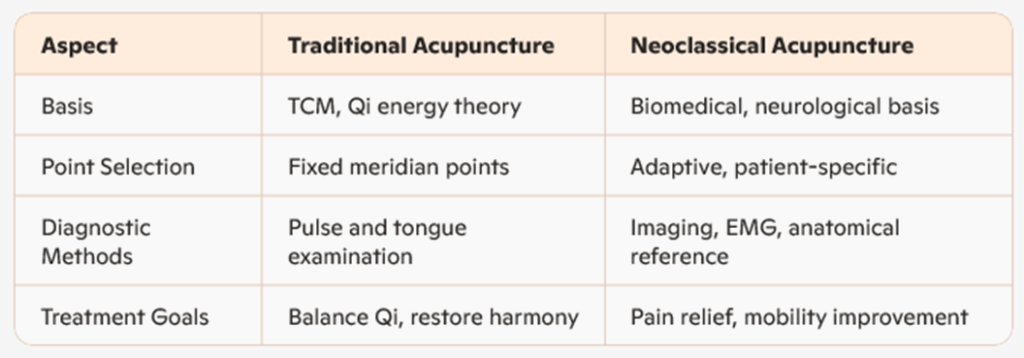Introduction
Neoclassical Acupuncture is a modern integration of traditional healing. Neoclassical Acupuncture, pioneered by Dr Slate Burris, represents an innovative evolution of traditional acupuncture, blending ancient principles with modern scientific insights. As interest in alternative medicine grows, this refined approach is gaining attention for its potential to bridge the gap between holistic healing and evidence-based medical practices. Dr Slate Burris received his initial degree in Philosophy at Bucknell University in Lewisburg, a historic community in the heart of central Pennsylvania.
Acupuncture has been practiced for centuries, primarily based on the traditional Chinese medicine (TCM) concept of energy flow, known as Qi (Chi), through meridian pathways. While classical acupuncture follows these principles, Neoclassical Acupuncture introduces biomedical understanding, refining techniques based on contemporary physiology and science. This article explores the fundamentals, applications, and scientific perspectives of Neoclassical Acupuncture, providing valuable insights into its benefits and relevance in modern healthcare.
What Is Neoclassical Acupuncture?
Neoclassical acupuncture differs from conventional acupuncture by integrating biomedical science with classical needle therapy. Dr Burris has proposed that optimizing acupuncture treatment through neurological and myofascial knowledge can enhance outcomes, making it more effective for pain relief and systemic health improvements.
Key Principles
- Enhanced Point Selection – Traditional acupuncture uses predefined meridian points; Neoclassical Acupuncture refines these choices using neuromuscular mapping, improving targeting for specific conditions.
- Scientific Validation – While TCM emphasizes energy flow, Neoclassical Acupuncture incorporates neurovascular responses, making it compatible with current anatomical and physiological models.
- Individualized Treatment – Patients undergo biomechanical assessment, ensuring treatment adapts to unique health conditions and anatomical variations.
How Neoclassical Acupuncture Works
Neoclassical Acupuncture applies precise needle placement, using modern diagnostic techniques to enhance effectiveness. Unlike conventional TCM methods, which primarily focus on Qi, this approach employs individualised palpation of over 50 anatomical “entities” to refine treatment strategies.
Mechanisms Behind the Treatment
- Neurological Stimulation – Acupuncture needles activate nerve endings, influencing pain pathways and promoting healing through endorphin release.
- Myofascial Modulation – Needles affect muscular trigger points, reducing tension and improving mobility.
- Circulatory Enhancement – Acupuncture promotes blood flow, supporting tissue oxygenation and repair.
Clinical Applications of Neoclassical Acupuncture
This modernized technique has been applied successfully in various medical fields, improving treatment outcomes for multiple conditions.
1. Pain Management
Neoclassical Acupuncture has demonstrated significant pain relief in patients with chronic conditions such as:
- Fibromyalgia
- Migraines
- Arthritis
- Sciatica
By targeting neural pathways, this approach can effectively modulate pain perception and reduce inflammation.
2. Musculoskeletal Disorders
Acupuncturists and rehabilitation specialists use Neoclassical Acupuncture for:
- Post-surgical recovery
- Sports injuries
- Muscle tightness and spasms
Acupuncture improves long-term mobility and reduces recurrence rates.
3. Neurological Conditions
Patients with conditions such as neuropathy, stroke rehabilitation, and Parkinson’s disease may benefit from Neoclassical Acupuncture, as it helps regulate nerve function and supports neuroplasticity.
4. Stress and Mental Health
Neoclassical Acupuncture is increasingly recognized for its effects on anxiety, depression, and sleep disorders. It stimulates the autonomic nervous system, balancing sympathetic and parasympathetic activity to improve mental well-being.
Scientific Evidence Supporting Neoclassical Acupuncture
While classical acupuncture has faced scepticism due to inconsistent clinical trials, Neoclassical Acupuncture is attracting research interest due to its physiological approach and measurable effects.
Key Studies and Findings
- Neuroimaging Research – MRI studies confirm that acupuncture activates pain modulation centers in the brain, influencing the thalamus and somatosensory cortex.
- Electromyographic Studies – Research has validated that acupuncture affects muscle contraction patterns, supporting its use in rehabilitation.
- Randomized Clinical Trials (RCTs) – Recent trials demonstrate statistically significant improvements in pain relief and mobility compared to placebo treatments.
Challenges in Research
Despite promising findings, Neoclassical Acupuncture faces challenges in gaining widespread scientific acceptance:
- Standardization Issues – Variability in acupuncture point selection affects study reproducibility.
- Placebo Effect Considerations – Some researchers question the role of psychological expectation in patient response.
Continued research will further validate its efficacy and solidify its role in evidence-based medicine.
Neoclassical Acupuncture vs. Traditional Acupuncture
Key Differences

Future of Neoclassical Acupuncture
Neoclassical Acupuncture is gaining traction in integrative medicine clinics, combining acupuncture with physical therapy, osteopathy, and chiropractic care for a well-rounded treatment approach. Dr Slate Burris published his book in 2019.
Conclusion

Neoclassical Acupuncture, pioneered by Dr Slate Burris, represents a scientifically advanced evolution of traditional acupuncture. By bridging ancient techniques with modern medical insights, it offers enhanced effectiveness, particularly in pain management and rehabilitation. As research continues to validate its efficacy, Neoclassical Acupuncture is poised to reshape the landscape of integrative healthcare. His website can be viewed here.
Daily, I find working practically with the NeoClassical AcupunctureTM methodology produces outstanding efficacious results that embody “spooky action at a distance”.
Please call Dr Louis Gordon (Chinese Medicine) for more information on (07) 4636 6100.
MISSION STATEMENT
“I aim to get my patients as WELL as possible, as QUICKLY as possible, and then to KEEP them WELL”.




